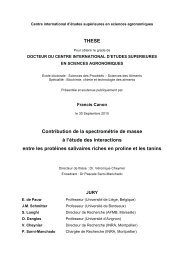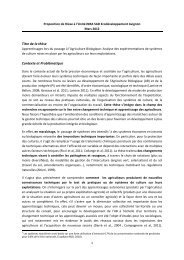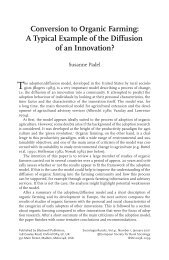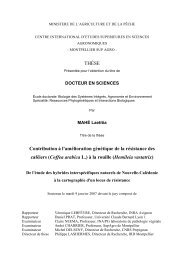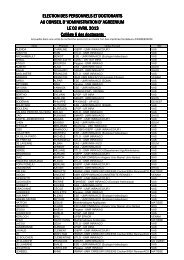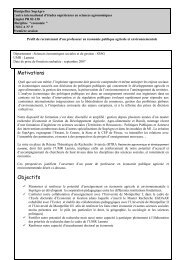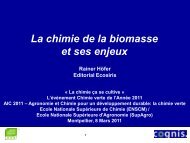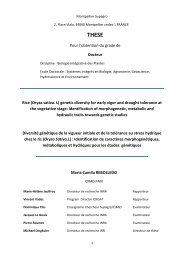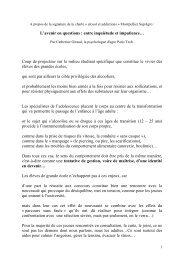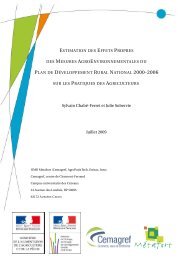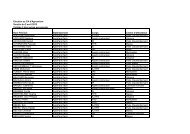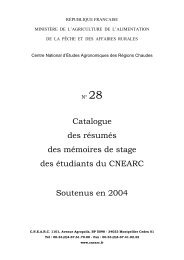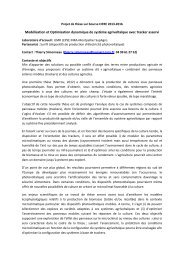Thèse Ndo - Montpellier SupAgro
Thèse Ndo - Montpellier SupAgro
Thèse Ndo - Montpellier SupAgro
Create successful ePaper yourself
Turn your PDF publications into a flip-book with our unique Google optimized e-Paper software.
Annexe : Effet de l’application de l’urée<br />
Abstract<br />
Phaeoramularia leaf and fruit spot disease of citrus (PLFSD) caused by Pseudocercospora<br />
angolensis is one of the most serious diseases which attacks citrus in tropical Africa. It also<br />
constitutes a threat for the other producer countries located in tropical zone. Chemical<br />
treatment is the only method used for effective control of this disease. However, in addition to<br />
causing ecological problems, this method lies beyond the reach local smallholders. The<br />
development of ecologically friendly strategies to ensure effective protection of citrus against<br />
P. angolensis, is thus necessary. To this end, a knowledge of PLFSD risk factors is prerequired.<br />
The purpose of this study was to specify, by means of a survey and experiments<br />
carried out in natural conditions, the effects of certain biotic and abiotic factors on the<br />
development of the disease. The survey was carried out in 39 sites belonging to 13 citrus<br />
production basins of the humid zones of Cameroon and targetted a collection of<br />
environmental and biological tree characteristics as well as a focus on the most<br />
epidermiologically important ones. Experiments on 8 sites enabled a confirmation and<br />
evaluation of suspected factors. A stepwise logistic regression analysis of survey data made it<br />
possible to target altitude, soil type, citrus species and vegetation type as main factors<br />
influencing disease development. Relations between these factors and disease incidence are<br />
illustrated in segmentation trees which define the levels of disease according to the evolution<br />
of these factors. Experiments confirmed the great sensitivity of grape fruit and orange trees to<br />
PLFSD while tangerine and Tahiti lime trees were less sensitive. Disease incidence increased<br />
with a rise in altitude and a reduction in temperature and rainfall. Soil texture (clay, sand and<br />
silt contents) proved to be more determinant in disease development than its chemical<br />
composition. The role of nitrogen fertilization was not demonstrated in disease epidemiology<br />
while the effect of shade was significant. An experimentation showed that trees planted under<br />
shade are less affected than those located in sunshine and increase in shade intensity conferred<br />
a reduction of disease incidence. A spatial structure analysis of the disease made it possible to<br />
highlight an aggregate structure indicating small scale disease dispersion. An analysis of the<br />
spatial structure of an agro_forestry farm showed an aggregate structure of the sub<br />
populations of constituent tree families. This structure suggested that the dispersion of PLFSD<br />
within such a farm would be limited between the various citrus aggregates. PLS regression<br />
analysis suggested that several of these parameters play a determinant role in contributing to<br />
the development of disease on grape fruit, orange trees and Satsuma mandarin trees. All<br />
results indicate the need for developing parameter specific strategies for controlling the<br />
disease. The development of integrated agro forest systems which enable a decrease of the<br />
pressure of pest and diseases is envisaged.<br />
Key-words: Pseudocercospora angolensis, leaf and fruit spot disease, citrus, epidemiology,<br />
risk factors<br />
203



